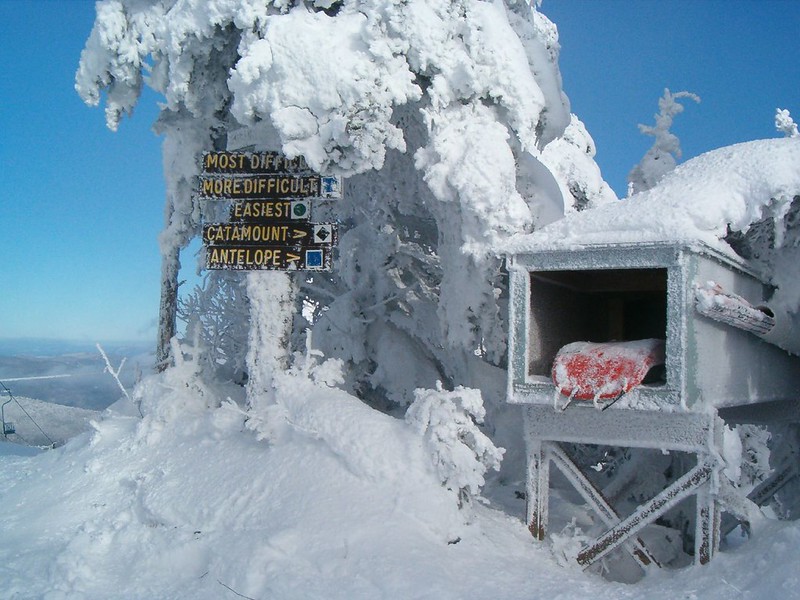
Did you wait too long to snag your Epic ski pass or the Ikon pass and are starting to scramble to find a ski destination for this winter? Consider grabbing your skis or snowboard and heading to Vermont for some incredibly authentic East Coast skiing.
The Green Mountain State shares six total mountains across the Ikon and Epic passes, but the state is also renowned for its catalog of high-quality independent mountains. Each of these mountains has a different feel to it, but they never stray from that “local mountain” vibe.

Why ski locally?
Think of these local mountains as little hole-in-the-wall diners, and the larger commercial mountains like Denny’s. You know what you’re going to get at Denny’s. The dining experience is repeatable and there isn’t too much separating one from the other. But unlike the Denny’s of the world, the little-hole-in-the-wall joints feel a bit more unique and laid back. The crowds are slimmer and it’s a bit less flashy, but it’s an experience completely of its own.
Plus, hitting up these independently owned diners will help give back. Your dough will go directly into the diner’s pockets and not to a bunch of corporate suits to divvy up among themselves. But enough of the diner analogy — let’s drop in and get the scoop on some gnarly local mountains in the great state of Vermont.

Smugglers’ Notch
Often referred to as “Smugg’s,” “Smuggler’s,” or in some cases, “The Notch,” this beautiful Vermont ski resort perched right down the road from Stowe has a little bit of everything, whether you’re crashing for the weekend as a family, or getting together with the squad for some afternoon turns.
First, the mountain is split into three peaks: Morse Mountain, Madonna Mountain, and Sterling Mountain. Morse Mountain is where you’ll find all the beginner terrain. It’s conveniently situated next to Smugg’s mountainside lodging and town center and is designed perfectly for family-friendly vacays.
Madonna and Sterling are only accessible from Morse Mountain by shuttle bus or from Morse’s beginner traverser, Midway, which you can find directly off the summit chair. Madonna and Sterling are where you’ll find intermediate and expert-only terrain.
For all you glade nuts and tree skiers, Smugg’s, in total, offers a whopping 750-plus acres of available woods skiing in between trails, along with tons of freestyle terrain to flash your steez. Did I mention Smugg’s is home to the northeast’s only triple-black diamond? Pro-tip: Follow signs for Black Hole when ripping down Madonna I lift line.
As a heads up, there’s not too much beginner terrain outside of Morse Mountain, so plan accordingly.

Bolton Valley
Just a 30-to-40-minute drive from the lakeside city of Burlington, Bolton Valley provides some of the most affordable and accessible high-quality skiing and snowboarding in northwestern Vermont. You can shred Bolton’s three peaks — Vista, Wilderness, and Timberline — for as low as $89 during non-peak dates. When you compare that to the $170 plus dollars you would spend for an all-day pass to other Vermont mountains like Sugarbush or Stowe, it’s practically highway robbery!
In terms of terrain, Vista Peak is Bolton’s most expansive. Off of the top chair, you get your choice of anything from corduroy groomers to (sometimes) knee-deep glades.
It may be hard to catch on a cloudy day, but a ginormous wind turbine sits off Vista Peak’s summit chair. Installed in 2009, this 100-plus foot wind turbine produces approximately 300,000 kilowatt hours of power annually and can start producing electricity at wind speeds as low as 6 mph. Bolton is Vermont’s first ski mountain to integrate a wind turbine on-site, and the second one nationwide.
Wilderness Peak offers less on-trail traffic than Vista, as well as some intermediate runs, expert-only terrain, and gnarly glades right off the lift line. Timberline Peak is the shortest of the three but is fantastic for beginners and those transitioning from beginner to intermediate, or intermediate to advanced. Its size cultivates a fantastic learning environment.
For those who enjoy skiing after dark, Bolton also offers skiing under the stars every Tuesday through Saturday from sunset to 10 p.m. Along with the plentiful alpine skiing, Bolton provides access to tons of Nordic and backcountry skiing throughout Mansfield State Forest. All Nordic trails are groomed, mapped, and marked, while the backcountry is a bit more scattered and reliant on snowpack conditions.

Mad River Glen
To all of my snowboarders, I’m sorry, but I have to exclude you from this next listing, as Mad River Glen is one of the few “skier-only” mountains left in the country.
Mad River’s predominantly natural snowpack, steeply sloped chutes, and dense tree coverage make it known among skiers as being one of the most technical mountains on the East Coast, punctuated with the slogan “ski if you can.”
The mountain’s dramatic single-chair lift unloads you at “The Glen’s” summit, more than 3,700 feet in elevation, surrounding you exclusively with expert-only, quad-burning terrain and more than 2,000 feet of vertical drop. Once up top, there’s only one way to go: Down.
For you adrenaline junkies, head skier’s left off the single chair and follow signs for “Paradise.” After a few jump turns and some mogul maneuvering, you will stumble upon Mad River’s notorious 38-degree pitched run. It will have even the biggest powder nuts triple-checking if they have the right line.
Now, Mad River is almost entirely expert-only and more difficult terrain, but beginners can also give The Glen a go. Hop on the Birdland chair, and you will be dropped off at the top of some gently sloping groomers.
All things considered, Mad River is about as authentic a “SKI THE EAST” experience as it gets. If you’re in the area, give ‘er a rip!



